(This is part III of a three-part report on Allan McCollum’s talk in this summer’s UArts Brown Bag Lunch Series,”Food for Thought” at the University of the Arts Wednesday. This part talks about the push and pull in McCollum’s work between uniqueness and copies. Here is part 1 and part 2.)
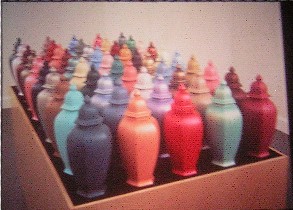 Allan McCollum noticed that ginger jars were often used as props to suggest uniqueness, wealth, connoiseurship–a symbolic art object. “Ginger jars were everywhere!” including on television shows. And they were already a symbol. “I’ll make a symbol of that symbol,” he said, and he called it “Perfect Vehicles.” Lo and behold, it was about religion, he said, about an object having an elevated value. So McCollum’s assembly line produced the solid, unjarlike ginger jars that eventually spawned the decor that Sid Sachs had espied at Strawbridge’s. McCollum’s ginger jars contained nothing but themselves, were full of themselves. How appropriate. He wondered, What does it mean if you have 50 of a thing? Does it make it have more value or less value (left, “Perfect Vehicles”)?
Allan McCollum noticed that ginger jars were often used as props to suggest uniqueness, wealth, connoiseurship–a symbolic art object. “Ginger jars were everywhere!” including on television shows. And they were already a symbol. “I’ll make a symbol of that symbol,” he said, and he called it “Perfect Vehicles.” Lo and behold, it was about religion, he said, about an object having an elevated value. So McCollum’s assembly line produced the solid, unjarlike ginger jars that eventually spawned the decor that Sid Sachs had espied at Strawbridge’s. McCollum’s ginger jars contained nothing but themselves, were full of themselves. How appropriate. He wondered, What does it mean if you have 50 of a thing? Does it make it have more value or less value (left, “Perfect Vehicles”)?
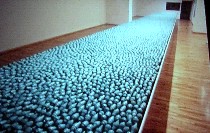 And then, inspired by the finials of ginger jars, he wondered “that an object should have a terminal point.” So he collected a huge quantity of mass produced shapes, cast them and combined them in ways that no two were alike, yet they looked like a line of mass-produced products, all painted one color. He had a suite he painted green, to recall a commercial attempt to paint something grass color, and another a pinky red for commercial flesh color. The piece is called “Individual Works.” The work, he complained, is often mistaken for being about consumerism, but that, he said is not what he’s about (right, “Over Ten Thousand Individual Works”).
And then, inspired by the finials of ginger jars, he wondered “that an object should have a terminal point.” So he collected a huge quantity of mass produced shapes, cast them and combined them in ways that no two were alike, yet they looked like a line of mass-produced products, all painted one color. He had a suite he painted green, to recall a commercial attempt to paint something grass color, and another a pinky red for commercial flesh color. The piece is called “Individual Works.” The work, he complained, is often mistaken for being about consumerism, but that, he said is not what he’s about (right, “Over Ten Thousand Individual Works”).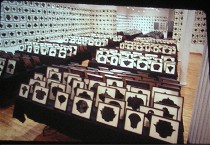 Somewhere around this time, he changed his method of display, using folding tables covered with table cloths to fill the gallery floor as well as walls with his multiples. The inspiration was trade shows (left, “Drawings,” each based on a unique combination of basic shapes, on display on folding tables).
Somewhere around this time, he changed his method of display, using folding tables covered with table cloths to fill the gallery floor as well as walls with his multiples. The inspiration was trade shows (left, “Drawings,” each based on a unique combination of basic shapes, on display on folding tables).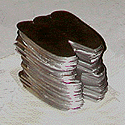
He has had several more pieces since then that hark back to his kit technique, combining in as many ways as possible a limited number of basic shapes to mass produce unique objects. He has done it not only in the finials, but in the series of “Drawings” and in “The New City Markers,” a series of unique combinations of basic shapes designed to hang on idividual homes in a housing development in Malmo, Sweden–to serve as an “address” without numbers (right, “The New City Markers,” made of aluminum).
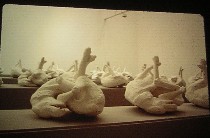
Other more recent work includes reproduced fossils on the theory that fossils are copies and then museums make copies of them, so why not mass produce more copies. (Left, “The Dog From Pompei,” these are replicas of the original plaster cast of a dog that had been buried alive in volcanic ash 79 A.D. in Pompeii.)
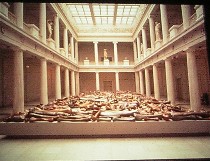
These pieces involved collaborations around the country with small museums. And these projects took him on a path involving mass reproduction of a number of natural phenomena and a number of local-community collaborations. McCollum wrote or collected and reproduced information about the projects, the brochures becoming part of the art, and you can find the information in PDF files on his website. (right, “Lost Objects,” cast dinosaur bones, produced in collaboration with the Carnegie Museum of Natural History. Here they are on display there, in a space that straddles the art museum and the natural history museum at the Carnegie, and therefore blurs the lines on where one discipline ends and the other begins. After this project, McCollum began seeking out small community museums to work with their collections).
The computer and the Internet were made for a person who loves mass replication. (He created his website himself, he told Sachs, before the talk.)
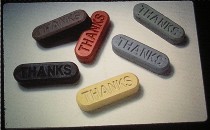
He has made generic gifts that sort of look like ingots imprinted with “thank you,” which he said were “objects with no meaning until they were exchanged.” These were reproduced by Philadelphia art reproductions manufacturer Cerealart (left, “The Visible Markers”).
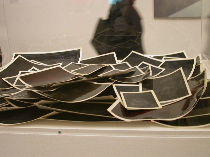
At the ICA’s “Big Bang,” McCollum’s “Glossies” looked like black photographs, but were in fact facsimiles with black rectangles for images that allowed the viewer to feel they were looking at photographs when in fact they weren’t (right, “Glossies).
Meanwhile, he said he is making a system large enough to produce 12 billion symbols, each one unique. Connected to this, he is wondering at how mass communication and the internet have made us more aware of the number of people in the world and how hard it is for us to take in that number and that each person is unique, so we make up stereotypes that reduce individuals to masses.
(Video recordings from the “Food for Thought” series are archived at the UArtsSummer MFA office and the UArts library. I wonder if the projected slide images look any better on video.)









